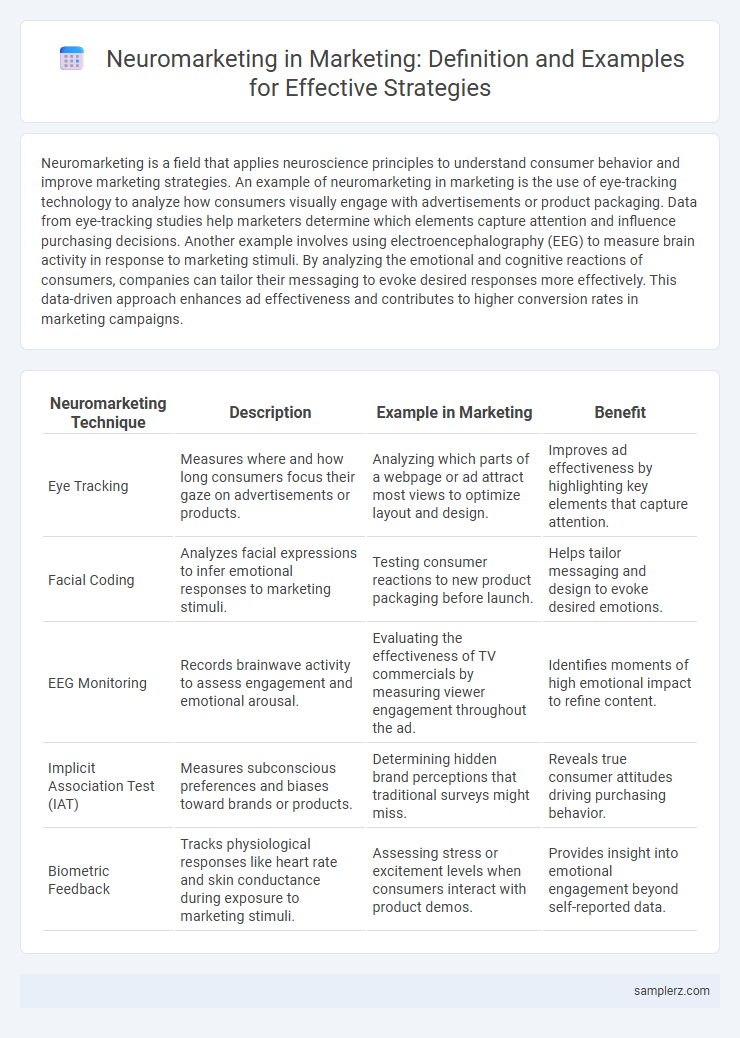Neuromarketing is a field that applies neuroscience principles to understand consumer behavior and improve marketing strategies. An example of neuromarketing in marketing is the use of eye-tracking technology to analyze how consumers visually engage with advertisements or product packaging. Data from eye-tracking studies help marketers determine which elements capture attention and influence purchasing decisions. Another example involves using electroencephalography (EEG) to measure brain activity in response to marketing stimuli. By analyzing the emotional and cognitive reactions of consumers, companies can tailor their messaging to evoke desired responses more effectively. This data-driven approach enhances ad effectiveness and contributes to higher conversion rates in marketing campaigns.
Table of Comparison
| Neuromarketing Technique | Description | Example in Marketing | Benefit |
|---|---|---|---|
| Eye Tracking | Measures where and how long consumers focus their gaze on advertisements or products. | Analyzing which parts of a webpage or ad attract most views to optimize layout and design. | Improves ad effectiveness by highlighting key elements that capture attention. |
| Facial Coding | Analyzes facial expressions to infer emotional responses to marketing stimuli. | Testing consumer reactions to new product packaging before launch. | Helps tailor messaging and design to evoke desired emotions. |
| EEG Monitoring | Records brainwave activity to assess engagement and emotional arousal. | Evaluating the effectiveness of TV commercials by measuring viewer engagement throughout the ad. | Identifies moments of high emotional impact to refine content. |
| Implicit Association Test (IAT) | Measures subconscious preferences and biases toward brands or products. | Determining hidden brand perceptions that traditional surveys might miss. | Reveals true consumer attitudes driving purchasing behavior. |
| Biometric Feedback | Tracks physiological responses like heart rate and skin conductance during exposure to marketing stimuli. | Assessing stress or excitement levels when consumers interact with product demos. | Provides insight into emotional engagement beyond self-reported data. |
Introduction to Neuromarketing in Modern Marketing
Neuromarketing leverages neuroscience tools such as fMRI and EEG to analyze consumer brain responses, enhancing understanding of decision-making processes in marketing strategies. Brands use eye-tracking technology and biometric data to optimize advertisements, packaging, and store layouts for increased engagement and sales. Integration of emotional and cognitive insights enables marketers to tailor campaigns that resonate deeply with target audiences, driving higher conversion rates.
Real-Life Brands Leveraging Neuromarketing Techniques
Brands like Coca-Cola utilize neuromarketing by incorporating sensory cues such as taste and sound to evoke emotional connections and enhance brand recall. Frito-Lay employs eye-tracking technology to design packaging that captures consumer attention and drives purchase decisions. Nike uses facial coding analyses to assess consumer reactions in advertisements, optimizing emotional appeal and engagement.
Neuromarketing in Advertising Campaigns
Neuromarketing in advertising campaigns leverages brain imaging techniques such as fMRI and EEG to understand consumer emotional responses and attention patterns, enabling the creation of highly targeted advertisements. Brands utilize implicit association tests and eye-tracking data to optimize visual elements and messaging for maximum engagement and recall. This scientific approach enhances campaign effectiveness by aligning marketing stimuli with subconscious consumer preferences and decision-making processes.
Sensory Branding: Using Sights, Sounds, and Smells
Sensory branding leverages neuromarketing principles by engaging multiple senses to create strong emotional connections and enhance brand recall. Companies use specific colors, sounds, and scents, such as Coca-Cola's signature red, Intel's five-note jingle, and Abercrombie & Fitch's proprietary fragrance, to influence consumer behavior and build brand identity. These sensory stimuli activate targeted brain regions associated with memory and pleasure, driving customer loyalty and purchase decisions.
Emotional Triggers in Neuromarketing Strategies
Emotional triggers in neuromarketing strategies leverage subconscious responses to influence consumer behavior, such as using color psychology where red evokes urgency and excitement. Brands implement sensory cues like nostalgic music or imagery to create emotional connections that increase brand loyalty and purchase intent. Eye-tracking studies reveal that emotionally charged advertisements hold attention longer, driving higher engagement and conversion rates.
Case Study: Neuromarketing in Retail Environments
Neuromarketing techniques were applied in a retail environment by analyzing customers' brain responses to product placements and store layouts, resulting in a 15% increase in sales for targeted items. Eye-tracking data revealed that strategically positioning high-margin products at eye level significantly improved visual engagement and purchase intent. This case study demonstrates how integrating neuroscience data with traditional retail strategies enhances consumer experience and optimizes merchandising effectiveness.
The Role of Eye-Tracking in Digital Marketing
Eye-tracking technology plays a crucial role in digital marketing by mapping consumer visual attention, enabling marketers to optimize website layouts and ad placements for maximum engagement. By analyzing gaze patterns and fixation durations, brands can identify which elements capture interest and which are ignored, refining content to boost conversion rates. This data-driven approach enhances user experience and increases the effectiveness of digital campaigns through targeted visual stimuli.
Neuromarketing and Packaging Design Innovations
Neuromarketing techniques leverage brain imaging and biometric data to optimize packaging design, increasing consumer engagement and purchase intent. Innovations include using color psychology, tactile elements, and visual cues that activate emotional and cognitive responses, enhancing brand recall and perceived value. Brands employing neuro-optimized packaging report higher sales conversion rates and improved customer loyalty.
Ethical Considerations in Neuromarketing Practices
Neuromarketing leverages brain imaging and biometric data to understand consumer behavior, raising critical ethical concerns about privacy and informed consent. Companies must implement transparent data collection practices and obtain explicit permission to avoid manipulation and protect consumer autonomy. Adhering to ethical guidelines ensures trust and long-term brand integrity in neuromarketing campaigns.
Future Trends of Neuromarketing in Marketing
Future trends of neuromarketing in marketing focus on integrating advanced biometric sensors and AI-driven data analysis to decode consumer emotional responses with higher precision. Predictive models leveraging neural data aim to tailor hyper-personalized marketing campaigns that dynamically adjust in real-time to customer reactions. The rise of virtual reality experiences combined with neuromarketing insights promises immersive advertising that deeply engages cognitive and emotional pathways for enhanced brand loyalty.

example of neuromarketing in marketing Infographic
 samplerz.com
samplerz.com